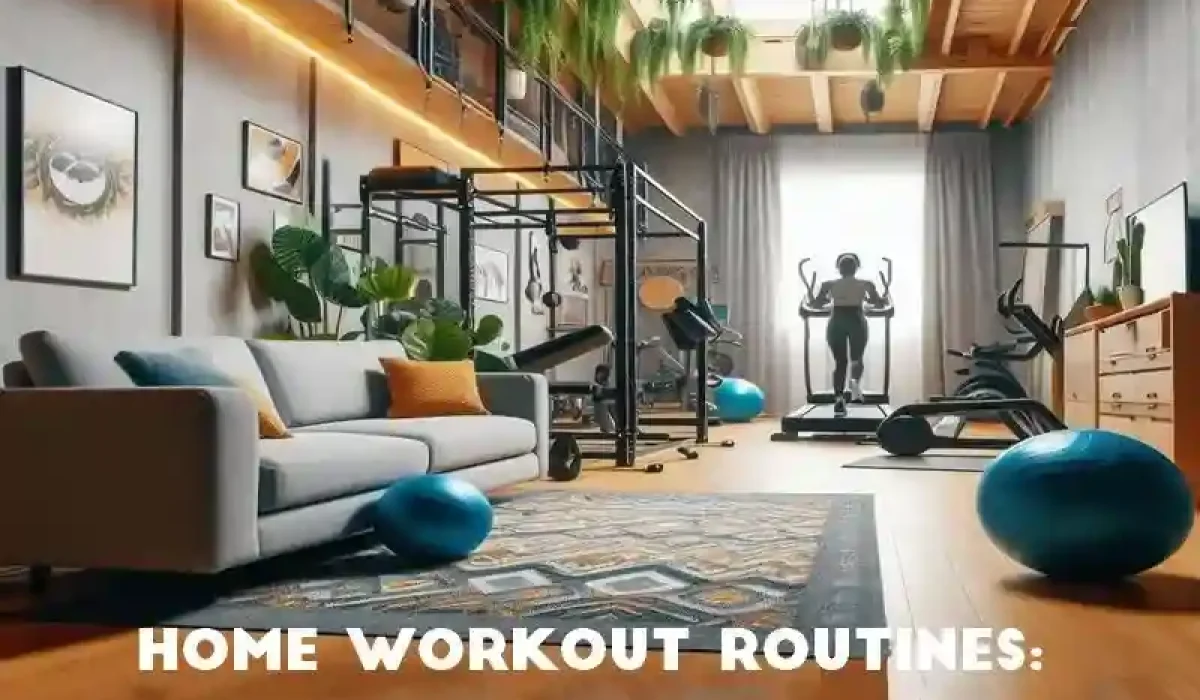Discover the benefits of home workout routines for improving physical fitness and mental health. No gym membership or fancy equipment like the Tonal gym is required. This article explores the connection between exercise and mental well-being, offering practical tips to get fit and battle depression and anxiety from the comfort of your own home.
Key Takeaways:
- Home workout routines provide a convenient and effective alternative to traditional gym sessions.
- Regular exercise can positively impact mental health, reducing symptoms of depression and anxiety.
- Designing a dedicated workout space within your home is key to creating a motivating environment.
- Essential equipment for home workouts, such as resistance bands and dumbbells, can enhance your exercise routine.
- Structuring a balanced home workout routine that targets different muscle groups is essential for overall fitness.
Understanding the Link Between Exercise and Mental Health
Regular exercise is not only crucial for physical fitness but also plays a significant role in maintaining mental health. Research has shown that engaging in physical activity can help reduce symptoms of depression and anxiety, promoting overall well-being.
Scientists have discovered that exercise stimulates the release of endorphins, commonly known as the “feel-good” hormones, which can improve mood and boost emotional well-being. These natural chemicals act as a form of stress relief, reducing feelings of sadness, anxiety, and tension.
Moreover, regular exercise has been found to increase the production of brain-derived neurotrophic factor (BDNF), a protein that supports the growth and maintenance of brain cells. Higher levels of BDNF have been associated with improved cognitive function and a decreased risk of mental health conditions such as depression and anxiety.
“Exercise is a powerful tool not only for physical well-being but also for mental health. It has the potential to alleviate symptoms of depression and anxiety, leading to a happier and healthier life.” – Dr. Emma Johnson, Psychiatrist
In addition to these physiological benefits, exercise also provides mental health benefits through social interaction and a sense of accomplishment. Participating in group fitness classes or team sports can foster a sense of community and support, reducing feelings of loneliness or isolation that often accompany mental health challenges.
It is important to note that exercise should not replace other methods of managing mental health conditions. However, incorporating physical activity into your routine, in conjunction with other treatments or therapies, can have a positive impact on your overall mental well-being.
By understanding the link between exercise and mental health, individuals can leverage the benefits of physical activity to support their journey toward improved mental well-being. In the following sections, we will explore the benefits of home workouts and provide practical tips for designing and maintaining a personalized fitness routine from the comfort of your own home.
The Benefits of Home Workouts
Discovering the convenience and effectiveness of home workouts can revolutionize your fitness journey. Whether you prefer to save time, and money, or have the freedom to personalize your exercise routine, working out at home offers a range of advantages. With flexibility and cost savings as key benefits, it’s no wonder that more and more people are embracing home workouts as a viable alternative to traditional gym sessions.
One of the greatest benefits of home workouts is the flexibility they offer. You have the freedom to exercise whenever it suits your schedule, eliminating the need to adhere to gym opening hours or manage crowded spaces. This flexibility ensures that you can prioritize your fitness goals without compromising on other commitments, making it easier to maintain a consistent routine.
Avoiding the expense of a gym membership is another substantial advantage. With home workouts, you can save money on monthly fees and avoid the additional costs associated with commuting or parking. This financial flexibility allows you to invest in other aspects of your well-being or fitness, such as purchasing exercise equipment or enrolling in virtual training programs.
Personalizing your exercise routine is another major benefit of home workouts. You have the opportunity to tailor your workouts to suit your preferred style, intensity, and goals. Whether you enjoy high-intensity cardio, strength training, or yoga, you have the freedom to create a routine that resonates with your fitness aspirations and preferences.
Opting for home workouts means embracing a level of convenience, customization, and cost-effectiveness that traditional gyms often lack. Plus, you’ll be amazed at the variety of exercises you can do with minimal equipment or even just bodyweight. It’s truly empowering!
Maintaining and improving your fitness doesn’t have to be limited to the boundaries of a gym. Embrace the benefits of home workouts and unlock a world of convenience, cost savings, and personalization. With the right motivation and dedication, achieving your fitness goals from the comfort of your own home is not only possible but also incredibly rewarding.
Designing Your Home Workout Space
Creating an ideal workout space within the comfort of your own home is essential for staying motivated and committed to your fitness goals. With the right setup, you can transform any corner or room into a dedicated area that inspires and supports your home workouts.
Here are some practical tips to design your home workout space:
- Choose a suitable location: Designate an area in your home that is spacious enough to accommodate your workout equipment and provide sufficient room for movement. Consider areas such as a spare room, garage, or even a corner of your living room.
- Clear the clutter: Remove any unnecessary items from the designated space to create a clean and organized environment. A clutter-free zone will not only improve safety but also enhance focus during your workouts.
- Ensure proper lighting: Good lighting is essential for creating an inviting and energizing atmosphere in your workout space. Natural light is ideal, but if that’s not possible, opt for bright artificial lighting to ensure visibility.
- Add mirrors: Mirrors are a great addition to any home workout space as they can help you maintain proper form and technique during exercises. They also create the illusion of a larger space.
- Invest in quality flooring: Consider installing gym flooring or using exercise mats to protect your floors and provide a comfortable surface for various exercises. This will also help reduce noise and impact on your joints.
- Personalize with inspiration: Decorate your home workout space with motivational quotes, posters, or images that inspire you to push harder and stay committed to your fitness journey.
“By designing a dedicated home workout space, you are making a commitment to prioritize your fitness and well-being. It’s a tangible reminder that you have everything you need to achieve your goals right at home.” – Fitness Expert
Remember, your home workout space should reflect your personality and fitness preferences. Customize it to create an environment where you feel motivated, comfortable, and ready to conquer your workouts.
Finding the Right Equipment
Once you have designed your home workout space, it’s time to consider the equipment you’ll need to maximize your workouts. From cardio machines to strength training tools, the choices are vast. It’s important to select equipment that aligns with your fitness goals and fits well within your designated workout space.
Equipment Description Dumbbells Versatile and essential for strength training exercises. Opt for adjustable dumbbells to save space. Resistance Bands Lightweight and portable, resistance bands are excellent for targeting specific muscle groups and adding variety to your workouts. Yoga Mat Provides cushioning and grip for floor exercises, yoga, and stretching routines. Jump Rope A simple yet effective tool for cardio workouts and improving agility. Exercise Ball Great for enhancing core stability and balance during exercises.
Essential Equipment for Home Workouts
When it comes to home workouts, having the right equipment can make all the difference in achieving your fitness goals. Fortunately, you don’t need a fully-equipped gym to get an effective workout. With a few essential pieces of equipment, you can create a versatile and challenging exercise routine right in the comfort of your own home.
Create your workout space
Before diving into the list of essential equipment, it’s important to designate a dedicated space for your home workouts. Choose an area that provides enough room for movement and has a supportive surface, like a carpet or exercise mat. Having an organized and inviting workout space will help you stay motivated and focused during your exercise sessions.
Must-have equipment
| Equipment | Benefit |
|---|---|
| Dumbbells | Allows for a wide range of strength exercises targeting different muscle groups. |
| Resistance bands | Provides variable resistance for strength training and allows for a full body workout. |
| Yoga mat | Offers comfort and stability for floor exercises and yoga routines. |
| Jump rope | A fun and effective cardiovascular exercise tool that burns calories and improves coordination. |
| Exercise ball | Perfect for core strengthening and improving balance and stability. |
These essential pieces of equipment provide a solid foundation for a well-rounded home workout routine. With dumbbells, resistance bands, a yoga mat, a jump rope, and an exercise ball, you’ll have the tools necessary to target various muscle groups, improve cardiovascular fitness, and enhance flexibility and balance.
Remember, the key to a successful home workout is not the quantity of equipment but rather the quality of exercises and consistency in your routine. Focus on proper form and technique to maximize results.
Additionally, if you have more space and budget, you can consider adding a stationary bike, a treadmill, or a suspension trainer to further diversify your workouts. However, these are optional and not necessary to get a challenging and effective home workout.
Structuring Your Home Workout Routine
Designing a structured and balanced home workout routine is crucial for targeting different muscle groups and promoting overall fitness. By following a well-planned routine, you can maximize the effectiveness of your workouts and achieve your fitness goals. Here are some tips to help you create a successful home workout routine:
1. Set Clear Goals
Determine what you want to achieve through your home workouts. Whether it’s building strength, losing weight, or improving endurance, setting clear goals will keep you motivated and focused during each session.
2. Create Variety
Include a mix of exercises in your routine to prevent boredom and engage different muscle groups. Incorporate cardio exercises like running or jumping jacks to get your heart rate up, along with strength training exercises using weights or resistance bands.
3. Focus on Different Muscle Groups
Divide your routine into specific workout days for different muscle groups. For example, you can target your upper body on one day, lower body on another, and incorporate core exercises on a third day. This approach allows for proper rest and recovery while ensuring all muscle groups are adequately trained.
4. Schedule Rest Days
Rest days are just as important as workout days in a well-structured routine. They allow your muscles to recover and rebuild, reducing the risk of injuries and promoting better overall performance. Aim for at least one or two rest days per week.
5. Track Your Progress
Keep a record of your workouts, noting the exercises, sets, repetitions, and weights used. Tracking your progress helps you see improvements over time and adjust your routine accordingly. Consider using a fitness app or a workout journal to easily monitor your achievements.
Tip: Don’t be afraid to modify and experiment with your home workout routine. Listen to your body and make adjustments as needed. It’s essential to find a routine that works best for you and keeps you motivated.
By structuring your home workout routine with clear goals, variety, and focus on different muscle groups, you can make the most out of your at-home fitness journey. Remember to schedule rest days and track your progress to ensure continuous improvement and long-term success.
Exploring Different Types of Home Workouts
When it comes to home workouts, the options are endless. Whether you’re looking to build strength, improve flexibility, or simply stay active, there is a fitness routine for everyone. Here, we explore a range of home workout styles that cater to different goals and preferences.
1. High-Intensity Interval Training (HIIT)
If you’re short on time but still want an effective workout, HIIT is the way to go. This intense form of exercise involves short bursts of high-energy activity followed by brief rest periods. HIIT workouts often combine a mix of cardio and strength exercises, helping you burn calories and build muscle in a shorter amount of time.
2. Yoga
Yoga is not only a great way to improve flexibility and balance, but it also promotes relaxation and mental well-being. With various styles to choose from, such as Hatha, Vinyasa, and Restorative, you can find a yoga practice that suits your fitness level and goals. Roll out your mat and discover the benefits of this calming and strengthening workout.
3. Bodyweight Exercises
No equipment? No problem. Bodyweight exercises are simple yet effective, using nothing but your own body as resistance. From push-ups and squats to lunges and planks, bodyweight workouts can be done anywhere, making them ideal for home fitness routines. Plus, they can be easily modified to challenge different muscle groups and fitness levels.
4. Dance Fitness
Turn up the music and let loose with dance fitness workouts. Dance-based cardio routines, such as Zumba or Dance Cardio, combine aerobic exercise with fun and energetic moves. Not only do these workouts get your heart pumping, but they also improve coordination and agility, all while having a blast.
5. Pilates
Developed by Joseph Pilates, this low-impact workout focuses on core strength, flexibility, and posture. Pilates exercises often incorporate slow and controlled movements that target specific muscles while emphasizing proper alignment and breath control. With a wide range of equipment options available, from reformers to resistance bands, Pilates can be easily adapted for home workouts.
6. Cardio Kickboxing
If you’re looking for an intense and empowering workout, cardio kickboxing might be the perfect fit. Combining martial arts-inspired moves with cardiovascular exercises, this high-energy workout helps improve cardiovascular endurance, coordination, and overall strength. Punch, kick, and sweat your way to a fitter you.
7. Circuit Training
Circuit training involves performing a series of exercises back-to-back with minimal rest in between. This type of workout targets multiple muscle groups and keeps your heart rate up, making it an efficient and time-saving option. You can design your own circuit workouts using a combination of bodyweight exercises, dumbbells, and resistance bands.
8. Online Workout Classes
One advantage of home workouts is the abundance of online fitness classes. From live streaming sessions to on-demand workout libraries, you can find virtual classes for almost any fitness style or level. Whether you prefer cycling, barre, or strength training, online classes offer professional guidance and the motivation of a group setting right in the comfort of your own home.
Workout Style Fitness Benefits High-Intensity Interval Training (HIIT) Burns calories, builds strength, improves cardiovascular health Yoga Increases flexibility, improves balance, reduces stress Bodyweight Exercises Strengthens muscles, improves endurance, requires minimal equipment Dance Fitness Cardiovascular workout, improves coordination, boosts mood Pilates Enhances core strength, improves posture, promotes mind-body connection Cardio Kickboxing Cardiovascular endurance, full-body workout, stress relief Circuit Training Targets multiple muscle groups, increases cardiovascular fitness, time-efficient Online Workout Classes Access to professional guidance, variety of fitness styles, flexibility in scheduling
Whether you prefer intense workouts, mind-body connection, or dance-inspired movements, there is a home workout style that will keep you motivated and help you reach your fitness goals. Experiment with different types of workouts to find what resonates with you and enjoy the convenience of exercising in the comfort of your own home.
Motivating Yourself and Staying Consistent
Consistency is key when it comes to achieving and maintaining your fitness goals. However, staying motivated and committed to your home workout routine can sometimes be challenging. Here are some practical tips to help you stay motivated and consistent:
Set Realistic Goals
Start by setting achievable and realistic goals for yourself. Consider both short-term and long-term objectives that align with your overall fitness aspirations. By setting realistic goals, you can measure your progress and celebrate your achievements along the way, which helps to keep you motivated.
Create a Schedule
Establish a workout schedule that fits into your daily routine. Treat your home workouts as important appointments that you can’t miss. By consistently dedicating specific times to exercise, you are more likely to stay consistent and make it a habit.
Find an Accountability Partner
Having someone to hold you accountable can greatly boost your motivation and consistency. Partner up with a friend, family member, or neighbor who shares similar fitness goals. You can check in with each other regularly, offer support and encouragement, and celebrate milestones together.
Switch up Your Routine
Keeping your workout routine fresh and exciting can prevent boredom and help you stay motivated. Incorporate a variety of exercises, try different workout styles, and explore new fitness trends. This not only challenges your body but also keeps your mind engaged and eager to continue.
Reward Yourself
Give yourself regular rewards for sticking to your home workout routine. Whether it’s treating yourself to a new workout outfit, indulging in a relaxing massage, or enjoying a guilt-free rest day, rewarding yourself can serve as a positive reinforcement that motivates you to keep going.
Remember, motivation may fluctuate, but consistent action is what will ultimately lead to results. Stay positive, stay committed, and you’ll soon reap the benefits of your hard work!
Conclusion
Home workouts offer a multitude of benefits for both physical fitness and mental health. By exercising in the comfort of your own home, you have the accessibility and flexibility to fit workouts into your busy schedule. Whether you’re battling depression or anxiety or simply looking to improve your overall well-being, home workouts provide a convenient and effective solution.
Not only do home workouts eliminate the need for a gym membership, but they also allow you to personalize your exercise routine according to your preferences and goals. You can design a structured workout plan that targets different muscle groups and promotes overall fitness. From HIIT workouts to yoga and bodyweight exercises, there are countless options to explore and find your perfect fit.
Creating a dedicated workout space within your home is another key aspect of successful home workouts. By setting up an area that inspires and motivates you, you’ll be more likely to stay consistent with your exercise routine. With the right equipment, whether it’s simple resistance bands or versatile dumbbells, you can enhance your workouts without breaking the bank.
So, why wait? Start your journey to improved physical fitness and mental health today with home workouts. Embrace the convenience, flexibility, and personalized approach that exercising at home offers. Take control of your well-being and experience the transformative power of home workouts in your life.




